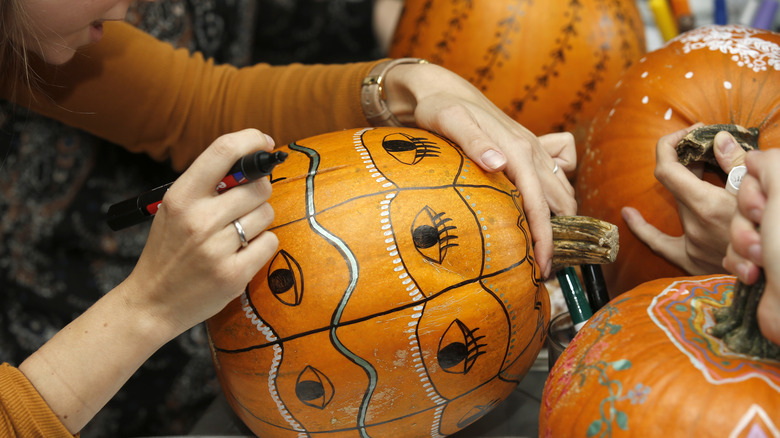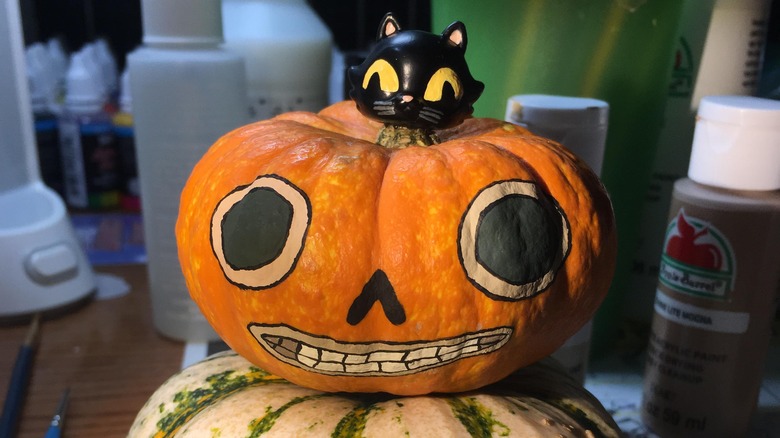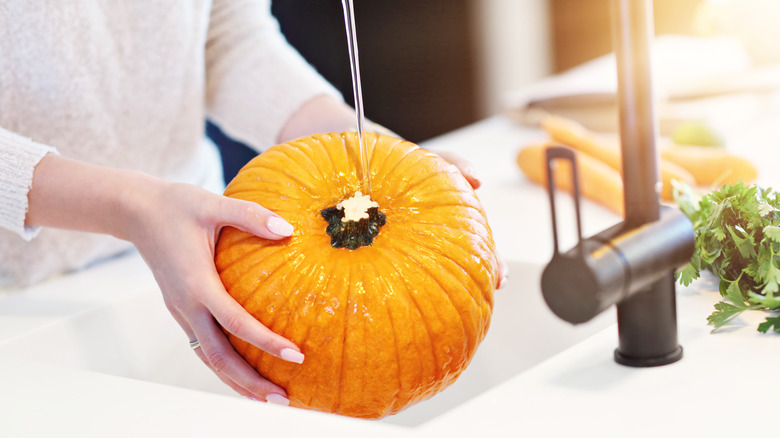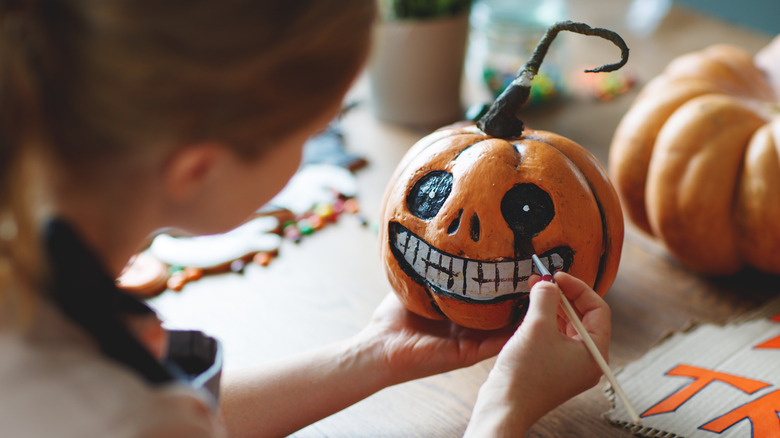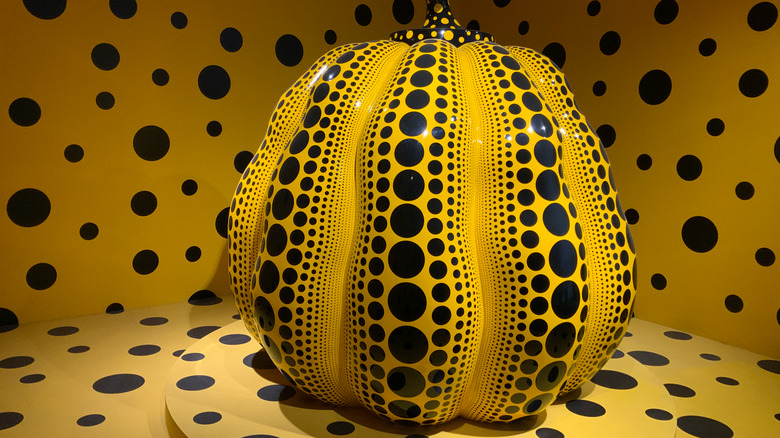5 Ways To Nail Pumpkin Painting This Spooky Season
You don't have to be a professional artist to create stunning decor using gourds. Pumpkins have enjoyed the spotlight for centuries as a canvas for masterpieces, from traditional jack-o-lanterns to sophisticated works by artists like Yayoi Kusama (via the Smithsonian). Their relatively smooth surfaces respond well to paint and other craft materials, and they're one of the most beloved emblems of autumn's arrival. "It's a vegetable that represents this idyllic farm life...and Americans have become attached to that," pumpkin expert Cindy Ott tells NPR.
Painted pumpkins can work well as indoor or outdoor decor and can be easily purchased at many retailers, from grocery stores to local farm stands. This is good news for fans of spooky season who may have noticed that Halloween decorations are hard to find or even sold out entirely this year. "Target is already sold out of the best Halloween stuff...I knew it'd be gone if I waited to think about it," lamented Twitter user @amockingbird earlier this month.
Pumpkins and craft paints are comparatively cheaper than storebought designs, which can help ease the strain on your bank account. According to Statista, the average price of one real pumpkin will set you back roughly $5. An artificial pumpkin like the 14" Painted Pumpkin from Target's Hyde & EEK! Boutique costs $15.00 in comparison. With a bit of ingenuity and some paint, you can bring your aesthetic goals to life with pumpkins this Spooktober. Here are five tips to help your designs shine.
Choose a theme for your design plans
Before you start sketching or painting, it can be helpful to brainstorm what you want to surround your home with to celebrate. Maybe you'd like to pay tribute to the films of your favorite horror director or keep it simple with funny faces or easy-to-draw figures like ghosts on your gourds. You can certainly choose to incorporate a little of everything amongst your pumpkins, but creating a series of designs each year can be fun to reflect on for the future. No matter which direction you go in, pumpkins will tie the look together. "Pumpkins, with their natural orange color which spells 'Halloween,' will enhance and warm up the entrance area and steps of any home," interior design expert Jennifer Corredor told CBS Miami.
You'll also have to decide on the size of the pumpkin you'd like to work with beforehand. For those fortunate to have stoops or front lawns to share their designs with the neighborhood, bigger can be better to display your works to passersby. If you're limited by shared space or apartment living, miniature gourds can be the way to go. Don't worry that your creativity will suffer from a lack of space: Redditor Thanos_minion shared a particularly cute painted mini-pumpkin design that paid homage to the popular television miniseries "Over The Garden Wall."
Start by priming the pumpkin as a canvas
Many great paintings start with a primed surface. To help your pumpkin look its best, give it a good scrub before you dive in, just like you would with other produce you bring home. Fresh pumpkins usually have a coating of dirt or debris due to rolling around in their patch. "Pumpkins with intact stems are a good indicator of a fresher pumpkin. If it's greener, it's really fresh. If it's browner or really dried out, it's an older pumpkin," master pumpkin carver Marc Evan explained to WHTM-TV.
According to experts from Washington State University, the warty appearance of some pumpkins can be due to bacteria rather than breeding. Even if you think your pumpkin looks fine, cleaning it will prolong its life as a decoration by minimizing pathogens that can cause it to decay prematurely. A smoother pumpkin will be easier to paint fine details on, but a pumpkin with blemishes can add character to your work, depending on the subject. For example, a textured pumpkin can enhance monsters, zombies, and portraits of characters like Freddy Kreuger.
Pick your paints and materials
When painting pumpkins or organic materials, there's a clear winner for the best paint choice. "[Acrylic paint] is quick-drying, easy to use, and clean-up is a breeze. Because [it's] water-based, if you mess up, you can wipe it off with a rag and start over," studio proprietor Becki Thomas told MarthaStewart.com. Acrylic is also affordable. For instance, at $1.69 per two-ounce tube, Folk Art Acrylic Paint is a good choice from Jo-Ann Stores. For added savings, you can fashion a makeshift palette to mix your colors from a paper plate, magazine, or an old Tupperware lid.
The brushes that you choose will have a significant impact on the quality and ease of your painting. Flimsy craft brushes, like the ones you received in cheap watercolor kits as a kid, will make it challenging to paint crisp lines. Nylon brushes, like White Synthetic Brushes by Artist's Loft Necessities from Michael's, are under $5 and perform exceptionally well. Remember to thoroughly clean your brushes after use, as acrylic paint is difficult to remove once it dries on them.
If your design involves layers, like a black bat flying in front of a white moon, you'll want to prep the pumpkin with the background color first to avoid smudging or muddling colors. While working with quick-curing paints like acrylics, you can use a hair dryer to speed up drying time. Just be careful to let the paint set somewhat to avoid unintentional drips or changes to your design.
Use your pumpkin's build as inspiration
If you're feeling stuck or having trouble painting, try using the natural curvature of your pumpkin to come up with design ideas. The pumpkin's ridges are perfect guidelines for creating stripes or checkerboard patterns, or you can embellish them to make foliage-inspired motifs. If you struggle with elaborate designs and have an orange pumpkin, you can paint its top white and the base yellow to create an adorable candy corn look. Another simple idea is a "Beetlejuice"-inspired pumpkin, using black and white paint to alternate stripes vertically along your pumpkin's ridges. For those feeling extra spooky, try applying bright green paint drips to the crown of your pumpkin to create a slime-like effect.
Like Japanese artist Yayoi Kusama, you can use your pumpkin as a landscape for dots in concentric patterns or apply spots anywhere you choose. Yayoi's giant pumpkin sculptures have drawn crowds at David Zwirner Gallery, and you can pay tribute to them using DecoArt Extreme Sheen Metallic Acrylic Paint from Michael's as a base coat. To really make your creation pop, you can add puffy paint for dots. Try using Tulip Dimensional Fabric Paint, available at Jo-Ann Stores, for a textural element.
Make your pumpkin painting last longer
Once you've finished painting your pumpkin, you can varnish it using an acrylic-safe product for varnishing. Mod Podge, available at Wal-Mart and other major retailers, is an excellent choice to seal your work. If you don't seal your painting, it will be more susceptible to damage from the elements, as acrylic paint can be prone to chipping.
However, don't expect your work to last forever. Even after you've sealed your pumpkin, it can still begin decomposing, leading to unfortunate seepage over time. Ensure you display your piece on a protective surface, like a plant saucer, to avoid damaging furniture or surrounding objects. Outdoor pumpkins may outlast those indoors, depending on your local climate. "Whole pumpkins generally last around two to three months in cooler temperatures such as on your covered porch," garden editor Rachel Crow explained to Homes & Gardens.
Since pumpkins have a shelf life, take plenty of photos to remember your hard work. Even better, consider hosting a party in person or virtually to paint with friends. If you can carve out the time, gourd artwork could become an annual tradition for those in your circle.
